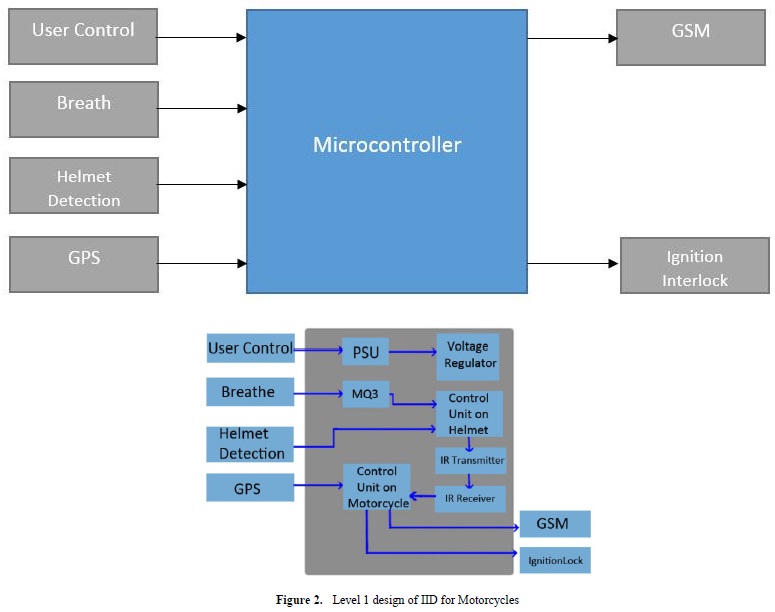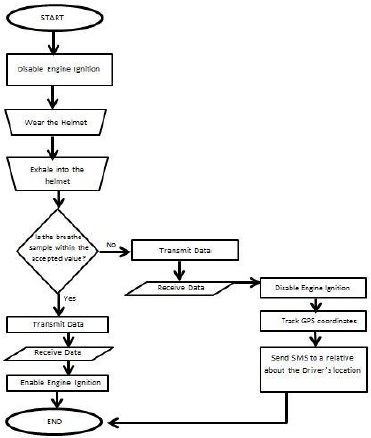





Published on Nov 30, 2023
Ignition Interlock Device or IID is a mechanism installed inside a vehicle which requires the driver to breathe into the device before starting the vehicle. If the IID detects that the alcohol level or blood alcohol content (BAC) is higher than the accepted value, the engine will not start. If the driver isn’t able to provide a clean breathe sample, the IID will log the event, warn the driver, and then start up an alarm. The purpose of the IID is to prevent accidents due to driving under influence (DUI). With the rise of two-wheeled vehicle in the Philippines due to its mobility and purchasing power, IIDs are still mainly installed on four wheeled vehicles. Even though riding motorcycle when drunk is more dangerous, there are only a small number of installed devices on motorcycles and scooters. The general objective of this study was to develop a system with hardware and software components that would implement IID on motorcycles.
The study employed descriptive method of research. The study also concluded the following: the infrared must have a point-to-point communication, the breathalyzer on the helmet should react to ethanol, the microcontroller on the motorcycle should accept all IR signals from the helmet and interpret it and the GPS shield should have an unobstructed line-of-sight communication with the GPS satellites.
Ignition Interlock Device or IID is a mechanism installed inside a vehicle which requires the driver to breathe into the device before starting the vehicle. If the IID detects that the alcohol level or blood alcohol content (BAC) is higher than the accepted value, the engine will not start. IID will also require another breath sample at random times to prevent someone other than the driver from providing the breath sample. If the driver isn’t able to provide a clean breathe sample, the IID will log the event, warn the driver, and then start up an alarm. The purpose of the IID is to prevent accidents due to driving under influence (DUI). One of the misconceptions when using IID is that it will simply turn off the engine if alcohol is detected. This would lead to an unsafe driving situation and expose the interlock manufacturers to be liable. A major component of the IID is the breathalyzer which determines the alcohol toxicity of the driver by exhaling to the device. The car breathalyzer calculates the BAC and only allows the car to start if BAC level is within the accepted value. These accepted values varies depending on the country as for the Philippines, it has a maximum of 0.5 mg/ml.
Commonly, IIDs come with a breathalyzer and a long cord embedded to the device placed above the car radio. In general, motorcycles have very limited space to install a device such as IID. This means that the location of IIDs on motorcycles is also a factor to consider. Since the IID requires another test while driving, the motorcycle driver can’t take another test while driving because leaving one hand away from the throttle will lead to an unsafe driving experience so their option is to stop for a while and proceed with the test. This can cause delay and if there aren’t any places for stopover like highways or expressways, the motorcycle driver will be in a pinch and will have a log details with negative results. Circumvention is another issue for IID installed on motorcycles. This means that the driver has a chance to allow a sober person to breathe in the device and pass the BAC which makes the engine start even though the driver is not the one who took the test. This situation is prevented by the law by extending the IID order to the offender and fining the person who provided the sample
The general objective of this study is to develop a system with hardware and software components that will implement IID on motorcycles. In line with this, the study aims to achieve the following specific objectives:
To integrate a sensor to check whether the driver is wearing the motorcycle helmet.
To install a breathalyzer in the helmet to determine the alcohol level of the driver.
To develop a control unit that will control the motorcycle actuators base on the data gathered by the sensors.
To implement GPS and GSM/GPRS on the project for determining the location of the driver when drunk and notify the acquaintance about his status and location.
To specify the type of alcohol that the breathalyzer can detect.
Indicate the level of alcohol content to activate the system.
The study employed descriptive method of research. It focuses on the details of the study specifically on the development of Ignition Interlock device designed for motorcycles. The idea behind this type of methodology is to study frequencies, averages and other calculations. Actual and systematic data gathering are used to determine the generated alcohol content level by using an alcohol sensor called MQ3. The value gathered by the MQ3 will be the basis of the system whether the system will allow the engine to work or not.

Fig. 1 shows the level 0 design of IID for Motorcycles shows theinputs to be User Control, breath of the driver, helmet detection and GPS and the outputs to be the ignition interlock and GSM.
Fig. 2 shows the level 1 design of IID for Motorcycles shows theuser control, breath of the driver, helmet detection and GPS and the outputs to be the ignition interlock and GSM. The PSU for the helmet used a power bank while the PSU for the control unit on the motorcycle used the motorcycle supply itself. The value gathered by the sensor MQ3 went to the control unit of the helmet and the control unit will sent a signal to the control unit on the motorcycle through IR. The control unit on the motorcycle determined whether it was necessary to proceed with the usage of the GSM and ignition lock.

Fig. 3 shows the system flowchart of IID for Motorcycles has a disabled engine ignition at the start of the system and waits for a signal from the helmet before it enables the engine ignition. The helmet is worn first and then the driver exhales into the breathalyzer installed on the helmet. The breath sample is analyzed and if it is not within the accepted value, the engine ignition remains disabled and then the GPS module works and gets the coordinates of the motorcycle. Using a GSM module, an SMS is sent to the relative of the driver to locate the driver. If the breath sample is within the accepted value, the engine ignition is enabled and the driver can use the motorcycle.
This study summarizes the following findings:
The unit test of MQ3 Sensor shows that the MQ3 sensor is calibrated according to the calibration correlated through the standard BAC chart.
The unit test of GPS Module shows that the GPS module gathers the correct location coordinates as verified through Google Maps.
The unit test of Infrared Module shows that its transmitter and receiver are able to communicate only when Line-of-Sight was established.
The unit test of relay shows that it is working well with Arduino simply by sending a logical state.
The unit test of GSM shows that the SMS is sent via GSM/GPRS module whenever it is turned on.
The integration test of IID Integration shows that the MQ3 sensor and infrared transmitter interacts with the GSM, GPS and Relay installed at motorcycle.
The acceptance test of Ignition Interlock Device for motorcycles shows that the device checks if the user wears helmet then ask for a breathe sample. If the sample passed legal BAC level, the engine will ignite. If not, the engine will not ignite and a SMS will be sent containing the GPS coordinates of the motorcycle. In case of helmet removal, the engine will stop.
This study concludes the following:
To achieve the integration of sensor to check if the driver is wearing the motorcycle helmet, the infrared transmitter and receiver should have a point-to-point communication in order for the receiver to receive the signal from the transmitter and it can also work as the sensor to check if the driver is the one taking up the breath sample test. Also, the micro switch in the helmet should be placed on top so that it can check if someone is wearing the helmet.
To achieve the installation of breathalyzer in the helmet to determine the alcohol level of the driver, the MQ3 sensor should react to ethanol and the sensor must be calibrated because the sensor is sensitive in humid environments. Also, the control unit in the helmet should be able to compute the alcohol level to properly determine if the driver has a BAC of 0.5% which determines if the system will prevent him from driving or not.
To achieve the development of control unit that will control the motorcycle actuators based on the data gathered by the sensors, the IR receiver connected to the microcontroller should accept all IR signals sent by the transmitter and interpret the signal if the system will let the motorcycle proceed to its normal operation. Also, the relay installed on the motorcycle should have the correct specifications based on the battery that the motorcycle uses.
To achieve the implementation of GPS and GSM/GPRS on the project for determining the location of the driver when drunk and notifying the acquaintance about his status and location, the antenna of the GPS should be placed on an unobstructed line-of-sight so that the satellite of the GPS system can easily determine the location of the motorcycle. 6. Recommendations This study recommends the following:
To improve the integration of sensor to check if the driver is wearing the motorcycle helmet, more switches can be installed inside the helmet to help in preventing the circumvention.
To improve the installation of breathalyzer in the helmet to determine the alcohol level of the driver, the MQ3 alcohol sensor can be change to a better sensor which does not require calibration sequence every time the system is switched on.
To improve the development of control unit that will control the motorcycle actuators based on the data gathered by the sensors, other actuators can be controlled such as horns and lights of the motorcycle to have a safer driving experience.
To improve the implementation of GPS and GSM/GPRS on the project for determining the location of the driver when drunk and notifying the acquaintance about his status and location, the SIM that will be used on the GSM shield can have a telecommunication plan so it won’t have any problems regarding the load necessary to send a SMS.
[1] Ignition Interlock Device [Online]. Available FTP: en.wikipedia.org/ Directory: wiki/Ignition_interlock_device.
[2] Craig Freudenrich, Ph.D. How Breathalyzers Work [Online]. Available FTP: http://electronics.howstuffworks.com/ Directory: documents/ieeecitationref.pdf.
[3] Blood Alcohol Concentration (BAC) Limits Worldwide (2013) [Online]. Available FTP: http://www.icap.org/ Directory: table/BACLimitsWorldwide.
[4] Authorized and Mandatory Installation of Ignition[Online]. Availabe FTP: https://www.dmv.ca.gov/ Directory: pubs/vctop/d11_5/vc23575.htm.
[5] Frequently Asked Questions About Ignition Interlock Devices, WI State Patrol Chemical Test Section, 2010.